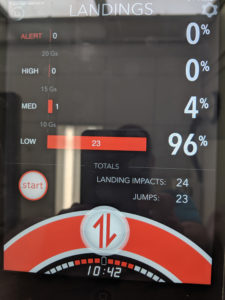Quantifying training stress is one of the most searched topics online within the performance coaching community. There are many rough “guidelines” presented by various experts, but not much scientific evidence to back up their reasoning. 24 hours to recover for an easy run, 48 hours for an interval workout, 72 hours for a hard tempo run, 48 hours for lifting weights, 72 hours for plyometric activities, etc., etc. What if you did some plyos, ran an interval workout, and topped it off with some weight lifting? How much recovery then? Do you add it all up (5 days to recover)? Go with the longest recovery (3 days for the plyos)? What does 72 hours recovery mean? Avoiding stressing the same system? Avoiding that specific type of exercise? Too many questions, not enough answers. But some technology may be catching up with specific exercises.
Plyometrics are often considered a high-stress activity and the potential injury risk too high compared to the potential gains. But some relatively new technology is working to quantify the G forces created on the landings. Vert is a small device that measures the displacement of the vertical movement of the body while calculating the speed of the movement and the weight of the subject jumping. These G forces are then sent to a mobile device in real-time to allow a coach to see the immediate effect on the body. The jumps are also calculated cumulatively so that you can see how many total landings have taken place and the level of stress (based on G force) of the total jumps taken. Here is a screenshot of a plyometric session using the Vert device and app with an XLR8 athlete:
 This workout was an introductory plyo workout. As you can see, 24 total landing impacts. Only one was above 10Gs of force. Even for an introductory workout, it was surprising to see how low the impact force was. These included one and two-foot forward hops and landings, as well as one and two-foot stair jumps. Again, not overly taxing, but not a lot of G force on the body. The workout took just over ten and a half minutes. More workouts and data will need to be collected to get a feel for total stress created within the workout. But, this does seem to be a way to quantify landing stress on the bones and joints.
This workout was an introductory plyo workout. As you can see, 24 total landing impacts. Only one was above 10Gs of force. Even for an introductory workout, it was surprising to see how low the impact force was. These included one and two-foot forward hops and landings, as well as one and two-foot stair jumps. Again, not overly taxing, but not a lot of G force on the body. The workout took just over ten and a half minutes. More workouts and data will need to be collected to get a feel for total stress created within the workout. But, this does seem to be a way to quantify landing stress on the bones and joints.
Keep an eye on next week’s blog to compare the landing force data of plyos vs. the landing force data of a moderate aerobic run.
– Ben
Don’t forget to follow us on Facebook, Instagram, and Twitter. Also, these performance tests are available for any athlete. Just click on the “Onsite Lab Tests and Pricing” on the main webpage.

